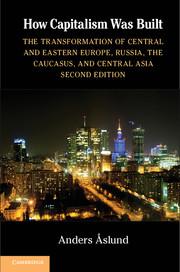 How Capitalism Was Built
How Capitalism Was Built Book contents
- Frontmatter
- Contents
- List of Tables and Figures
- Acknowledgments
- List of Abbreviations
- Introduction
- 1 Communism and Its Demise
- 2 Radical Reform versus Gradualism
- 3 Output
- 4 Liberalization
- 5 From Hyperinflation to Financial Stability
- 6 Privatization
- 7 The Social System
- 8 The Politics of Transition
- 9 From Crime Toward Law
- 10 The Importance of the European Union
- 11 The Global Financial Crisis, 2007–2012
- 12 Conclusions
- Bibliography
- Index
7 - The Social System
Published online by Cambridge University Press: 05 December 2012
- Frontmatter
- Contents
- List of Tables and Figures
- Acknowledgments
- List of Abbreviations
- Introduction
- 1 Communism and Its Demise
- 2 Radical Reform versus Gradualism
- 3 Output
- 4 Liberalization
- 5 From Hyperinflation to Financial Stability
- 6 Privatization
- 7 The Social System
- 8 The Politics of Transition
- 9 From Crime Toward Law
- 10 The Importance of the European Union
- 11 The Global Financial Crisis, 2007–2012
- 12 Conclusions
- Bibliography
- Index
Summary
The ultimate aim of economic policy is to enhance economic welfare. When transition to capitalism began, however, everybody anticipated social suffering, and in its early stages, postcommunist economic transformation often was presented as a social catastrophe. There was certainly trauma, and results have varied greatly among transition countries, but the initial perception of social disaster was exaggerated.
Chapter 3 concluded that the decline in registered output was highly exaggerated. Although we know even less about real incomes, they must have fallen less than output. Initially, real incomes plummeted, but they have surged with economic recovery. Income differentials have increased everywhere, but much more in the east and the south than in the west. Countries pursuing more radical initial reform, which generated less rent seeking, saw a smaller increase in inequality. Poverty ballooned in the poorer post-Soviet countries, but much poverty was shallow and has shrunk with economic recovery, as I discuss in the first section of this chapter.
The most disturbing social development, considered in the second section, was declining life expectancy among East Slavic and Baltic men, who found it difficult to adjust to the change of system. Infant mortality, by contrast, has fallen sharply throughout the region. This suggests that health care has improved in most countries, but the differences are considerable.
- Type
- Chapter
- Information
- How Capitalism Was BuiltThe Transformation of Central and Eastern Europe, Russia, the Caucasus, and Central Asia, pp. 215 - 238Publisher: Cambridge University PressPrint publication year: 2012
